|
Telltale Geometry in Anh Hung Tran's"The Scent of Green Papaya" by Ardavan Moayedi, edited by Gary Tooze |
"Falling apart from our origin" is at the crux of Ahn Hung Tran's debut film, "The Scent of Green Papaya". In my first viewing, the question which continually popped in my mind was “Couldn’t Tran find a location in entire of Vietnam (or outdoors) as opposed to creating one on an artificial set?" It was obvious to see by the lighting that he wanted to create a 100% natural looking neighborhood. Upon deeper analysis, if this is the case, then it is a big failure. The stage looks much like a television set. This made me question why there was a purposely built contrast between some scene elements that played such a significant role in the film. This is the focus of this article. | |
| Actually, I think the entire movie was uses this contrast in a highly critical nature. The camera movement is very gentle and soft. It has as few cuts as possible, but the subjects captured within the frame are quite the opposite, they are all struggling. No matter what, young or old, rich or poor, near and far, they are all striving toward something. And yet, they are unexceptionally inhibited to reveal their problems and ask for assistance. Some examples of this in the narrative would be as soon as the Mother - played by Thi Loc Truong - starts discussing their missing daughter with her husband - Ngoc Trung Tran - his response is: “Let’s not talk about it any more”. Even more defiantly, when the Old Thi tells the Mui that he had not seen his true love for so many years , she asks why he simply won’t go upstairs and see her? He replies (twice): “No, that’s IMPOSSIBLE, that is IMPOSSIBLE.” Accepting that actor’s role should not be defined accidentally and regarding the old man’s short appearance in the film, this was the dominant force of his portrayal and actually a very nice sequence of the film. Reminding us that even when he dared to go upstairs, he didn’t see his lover, he saw the picture of her missing son (positioned for someone else’s reason for struggle). | ||
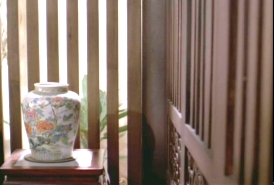 |
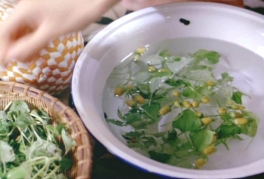 |
|
|
Character struggle and displacement is sampled throughout the film: The old maid, has misremembered dreams (talking to Mui while washing their faces early in the morning.) The parents who have lost their child, the wife whose husband keeps stealing the family money and disappearing, the father who keeps blaming himself for the death of their daughter, the grandmother who misses her dead husband and granddaughter, the old lover who has not seen his love for years and years. Even Mui, as the movie’s anchor, she has her very own problems as well. She must constantly deal with the families little trouble maker son who is constantly attempting to disturb her cleaning. But her demeanor is the conduit. Her activity suggests the respect and admiration of the natural world. Despite of her problems, she takes refuge and delight in the simple plants and insects that are defined in her small world. |
||
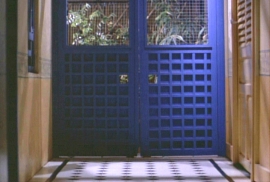 |
 |
|
|
This is all a condemnation of our society's rules and
regulations. This is the element which is being constantly –and non
stop- criticized throughout the entire film. There is some well spread
“patterned shapes”; manmade objects that are almost every where (and
that’s why I think the director needed to setup a stage the way he
wanted.) This pattern format even spreads itself to the sounds and we can find
clear examples as the family father’s repetitive traditional music
being played, grandmothers chimes and the son's piano. |
||
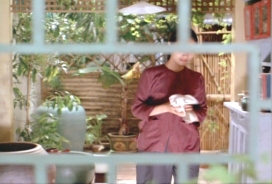 |
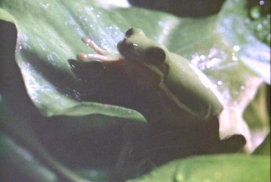 |
|
|
Why geometric patterns? I think it is one of the least forms you can find in nature. It is in complete contrast with the natural world and is an absolute representation of human creation. And this is the critical element in the whole movie; all doors, windows, fences, frames, pathways, chairs and furniture, etc. Even the piano (with its patterned keyboard) and Mui's picture drown on music notes paper. This is a way to demonstrate and illuminate that how much stress we’ve made for ourselves through our self made forms (which I supposed could be expanded to human relations). As a great example I can reference a scene in which a man brings some water for the family and after finishing his job, he exits the office and taps on maid’s shoulder through a window, which is covered with patterned lace. He gets his money where as he could have simply got it from his previous location. But there seems to be an intention to force people communicate through those sort of “self made patterned windows” rather than “open natural air”. |
||
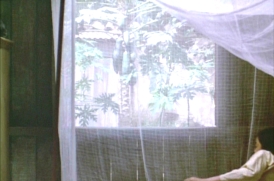 |
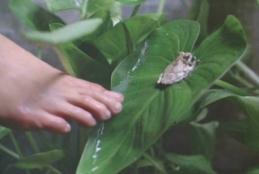 |
|
|
Mui is trying to break this setup and make more and more reference with nature by which she feels calm and relaxed. Another remarkable sequence of such confrontation is when the older Mui is about to leave the family. As a flash back, I refer you to where Mui caught a grasshopper and put it in an extremely small “hand made” cage (which also patterned, by the way!) In that sequence, the mother follows her from her hiding place without revealing how sad she is. But when they both finally dare to break this stupid rule and go beyond that and express their emotions (naturally) by hugging each other, then: the next scene is a close up of the little cage which is broken and the grasshopper freed! It couldn't be more obvious. |
||
 |
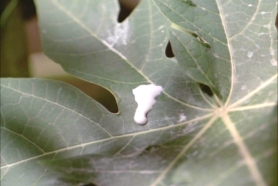 |
|
|
The entire film is full of such pointed examples and is very enjoyable to discover them, explore and think about. For every scene of parallel lines there is a corresponding (almost immediately) scene showing the beauty of the natural world. With its obvious inclinations I still think it is a very strong film and I really enjoyed watching and re-watching it. Such abstract approach to cinema is quite admirable and the film itself works on just the level of the sheer beauty of both the actress of older Mui (Tran Nu Yên-Khê) and the gorgeous art direction and scenery which almost builds as the film progresses. The camera's delicate pans are unique and refreshing. Enjoyable, beautiful, and thought provoking! What more can you ask from any film? |
||
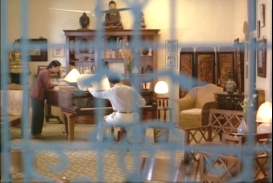 |
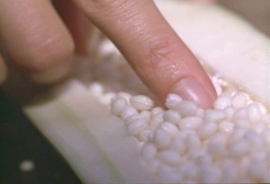 |
|